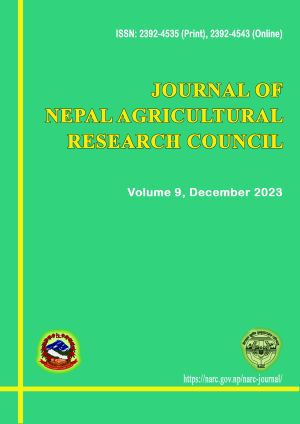Toxicity evaluation of essential oil of clove (Syzygium aromaticum) bud against Sitophilus zeamais Motschulsky (Coleoptera: Curculionidae)
DOI:
https://doi.org/10.3126/jnarc.v9i1.61583Keywords:
extraction, repellent, mortality, progeny, germinationAbstract
This study aimed to evaluate the efficacy, toxicity, and effectiveness of clove bud oils against Sitophilus zeamais in the stored maize variety Manakamana-4. The toxicity evaluation of the oil on maize weevils were conducted in completely randomized design (CRD) with eight treatments including seven different oil concentrations (10%, 5%, 2.5%, 1.25%, 0.625%, 0.3125% and 0.15625%) and control replicated four times at laboratory conditions in National Entomology Research Center, Khumaltar, Lalitpur, Nepal during 2020/2021. The results exhibited higher toxicity of clove oil to weevils after 72 h of oil exposure. Higher concentrations and longer exposure periods resulted in an increased mortality rate. Lower concentrations required a longer time for 50% of the weevil population to kill, whereas higher concentrations required a shorter time. Moreover, the essential oil was effective in causing the mortality of the weevil population at all three time intervals of 6, 10, and 16 days with varying mortality rate as lower concentrations required extended exposure time. In the same way, repellency assays of clove oil by applying four different concentrations (10%, 5%, 2.5% and 1.25%) on Whatman filter paper showed significant pest repellant activity. Repellent action was also highly dependent upon oil concentration and exposure time showing highest repellent activity (98.75%) at 10% concentration at 24 h interval. Additionally, it indicated higher the concentrations of clove oil higher the seed germination and fewer the weevil progeny emergence, and vice-versa. Since clove oil is considered to have low mammalian toxicity and a minimum risk pesticide, it can be incorporated into integrated pest management system in storage against maize weevils.
Downloads
Downloads
Published
How to Cite
Issue
Section
License
Copyright (c) 2023 Nepal Agricultural Research Council

This work is licensed under a Creative Commons Attribution-NonCommercial 4.0 International License.
This license enables reusers to distribute, remix, adapt, and build upon the material in any medium or format for noncommercial purposes only, and only so long as attribution is given to the creator.

